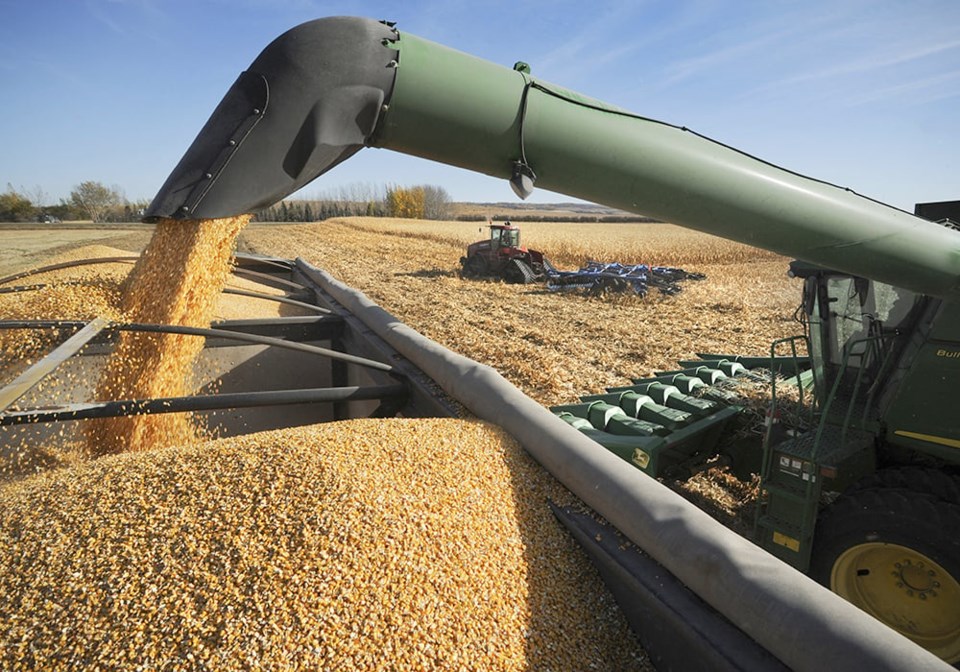SASKATOON — Grain growers should prepare for a year of falling prices and tight margins, says the chief economist of the U.S. Department of Agriculture.
Seth Meyer told delegates attending the USDA’s 100th Agricultural Outlook Forum to expect a continuation of the downward trend in commodity prices in 2024-25.
Corn prices are forecast to fall 8.3 percent, soybean values will tumble 11.5 percent and wheat prices are expected to drop 16.7 percent.
The news only gets worse for U.S. growers because while crop prices will plunge, input prices will remain “sticky.”
The exception is fertilizer prices, which have already been slashed, and interest rates, which are expected to come down in 2024.
“But for many of the other lines in a crop budget, they tend to be sticky when commodity prices fall,” said Meyer.
At least that was the case the last time there were commodity price spikes in 2008 and 2012 followed by collapsing values.
The upshot is that a corn grower in Illinois will be generating about $200 per acre in 2024 to pay for land costs and producer income.
“Anybody here think you could rent cash farmland in Illinois for $200 an acre?” said Meyer.
The USDA is forecasting that U.S. farmers will plant 91 million acres of corn, 87.5 million acres of soybeans and 47 million acres of wheat in 2024.
That compares to 94.6 million acres of corn, 83.6 million acres of soybeans and 49.6 million acres of wheat last year.
The price and profitability outlooks are grim due in a large part to fierce competition out of South America.
Farmers in Brazil, Argentina and Paraguay produced in excess of 200 million tonnes of soybeans in 2023-24, which is more than double what their output was at the turn of the century.
That was fine when Chinese demand for the oilseed was growing by four to eight percent per year. However, that is no longer the case.
“Who is going to pick up that demand as we get an additional six million tonnes per year from Brazil and two million from Argentina?” Meyer said.
U.S. producers are increasingly having to rely on the domestic market, which has been booming due to renewable diesel demand.
However, Meyer points out that soybean’s share of the biodiesel/renewable diesel feedstock is falling due to huge imports of products such as canola oil, used cooking oil and tallow.
The United States is also facing stiff competition from Brazil in the corn market. Acreage is on the rise in the South American country and its crop comes off three months before the U.S. crop.
China is suddenly importing a lot more corn from Brazil and barley from other countries and cutting back on U.S. corn.
U.S. corn ending stocks are expected to rise by 50 percent in 2023-24, which will result in lower prices in the year ahead.
U.S. wheat acres are expected to resume the long-term declining trend after a temporary bump in acres in 2023-24.
Ukraine’s exports have come storming back and are now at the same levels they were when the Black Sea Grain Initiative was operational.
“They’re just pushing the wheat out,” said Meyer.
“That’s one of the reasons we’re seeing some pressure on global wheat prices.”
But the main reason is that Russia has captured 30 percent of the global export market with its cheap and plentiful wheat supplies, and that is handcuffing U.S. sales of the product.
“While we might rebound off of our 50-plus-year low on wheat exports, it’s still going to be a problematic year,” he said.
The U.S. cattle industry remains in the contraction phase of the cycle due to three years of drought in the western part of the country and high interest rates.
“Even if you decide this spring to retain those animals, that’s not a steak until 2027 or late 2026,” said Meyer.
Hog farmers have been trying to reduce their herds in response to poor returns, but the number of pigs per litter has been on the rise due to improved management techniques.
“They cut farrowing a bunch, they cut breeding a bunch and they got it all back because of this jump in pigs per litter,” he said.
Pig prices are expected to be flat to slightly higher in 2024-25, but those are not great prices given where feed costs have been.
There should be some support in dairy prices as slow growth in the volume of milk per cow bumps up against firm demand for the product, said Meyer.
Contact [email protected]




